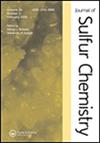Solvent-free synthesis of novel 1,3-thiazolidin-4-one-5-arylidene derivatives via cyclocondensation
IF 1.6
3区 化学
Q3 CHEMISTRY, MULTIDISCIPLINARY
引用次数: 0
Abstract
The 1,3-thiazolidin-4-one scaffold is a well-known pharmacophore in medicinal chemistry, valued for its broad spectrum of biological activities.
In this study, we report the design and efficient synthesis of a new series of 1,3-thiazolidin-4-one-5-arylidene derivatives 7a-j. The synthetic strategy began with the cyclocondensation of phenylhydrazide intermediates (3a and 3b) with mercaptoacetic acid under solvent-free conditions, using a few drops of acetic acid. This reaction yielded the key thiazolidinone intermediates (5a and 5b). Subsequent condensation with benzaldehyde or its substituted derivatives (6a – j) in the presence of sodium ethanolate (CH3CH2ONa) afforded the target compounds (7a – j) in yields ranging from 50% to 86%. The structures of all synthesized compounds were confirmed through details spectroscopic analyses, including 1H, 13C Nuclear Magnetic Resonance (NMR), and High-Resolution Mass Spectrometry (HRMS).
新型1,3-噻唑烷-4- 1 -5芳基烯衍生物环缩合无溶剂合成
1,3-噻唑烷-4- 1支架是药物化学中众所周知的药效团,具有广泛的生物活性。在这项研究中,我们报道了一系列新的1,3-噻唑烷-4- 1 -5芳基烷衍生物7a-j的设计和高效合成。合成策略首先是在无溶剂条件下,用几滴乙酸将苯肼中间体(3a和3b)与巯基乙酸进行环缩合反应。该反应产生了关键的噻唑烷酮中间体(5a和5b)。随后在乙醇酸钠(CH3CH2ONa)存在下与苯甲醛或其取代衍生物(6a - j)缩合,得到目标化合物(7a - j),收率从50%到86%不等。所有合成化合物的结构通过详细的光谱分析,包括1H, 13C核磁共振(NMR)和高分辨率质谱(HRMS)确认。
本文章由计算机程序翻译,如有差异,请以英文原文为准。
求助全文
约1分钟内获得全文
求助全文
来源期刊

Journal of Sulfur Chemistry
CHEMISTRY, MULTIDISCIPLINARY-
CiteScore
4.10
自引率
9.10%
发文量
38
审稿时长
6-12 weeks
期刊介绍:
The Journal of Sulfur Chemistry is an international journal for the dissemination of scientific results in the rapidly expanding realm of sulfur chemistry. The journal publishes high quality reviews, full papers and communications in the following areas: organic and inorganic chemistry, industrial chemistry, materials and polymer chemistry, biological chemistry and interdisciplinary studies directly related to sulfur science.
Papers outlining theoretical, physical, mechanistic or synthetic studies pertaining to sulfur chemistry are welcome. Hence the target audience is made up of academic and industrial chemists with peripheral or focused interests in sulfur chemistry. Manuscripts that truly define the aims of the journal include, but are not limited to, those that offer: a) innovative use of sulfur reagents; b) new synthetic approaches to sulfur-containing biomolecules, materials or organic and organometallic compounds; c) theoretical and physical studies that facilitate the understanding of sulfur structure, bonding or reactivity; d) catalytic, selective, synthetically useful or noteworthy transformations of sulfur containing molecules; e) industrial applications of sulfur chemistry; f) unique sulfur atom or molecule involvement in interfacial phenomena; g) descriptions of solid phase or combinatorial methods involving sulfur containing substrates. Submissions pertaining to related atoms such as selenium and tellurium are also welcome. Articles offering routine heterocycle formation through established reactions of sulfur containing substrates are outside the scope of the journal.
 求助内容:
求助内容: 应助结果提醒方式:
应助结果提醒方式:


